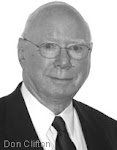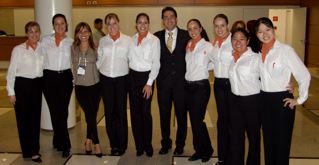The basic idea of Donald Clifton, Peter Drucker and other authors of the “strengths movement” is that we should focus more on developing our strengths than on fixing our weaknesses. One of the biggest obstacles in this quest is our lack of vocabulary for strengths. To quote Peter Drucker:
“Most Americans do not know what their strengths are. When you ask them, they look at you with a blank stare, or they respond in terms of subject knowledge, which is the wrong answer”
In order to find a remedy for this, the academic psychologist Donald Clifton worked many years on creating something like a taxonomy of 34 talents, along with an assessment of 180 questions that allows to identify those 34 talents. This on-line assessment is owned by the Gallup organization. If you buy a book like “Strengthsfinder 2.0” or “Now, Discover Your Strenghs”, you will get an access code that allows you to do the full online assessment but it will give you only your Top 5 talents.
That’s a pity because in my opinion you need to know your top 10 to 12 talents in order to really get a solid understanding of your talents and possible strengths. The only way to get access to your full 34 talents is by hiring Gallup’s consulting services which is something that only companies can do, but not individuals for themselves (at least as far as I know).
The good news is that the StrengthsFinder is by far not the only “way to Rome”. There are many other assessments available these days which are often personality-based assessments. As I have written elsewhere in this blog there seems to be quite some controversy among academic psychologists about how to define and measure personality, and to what extent personality really explains workplace performance. Dr. Hogan is one academic who defends very much the importance of personality for workplace, team and leadership performance. He writes in one of his books (p. 19):
“Well-developed assessment procedures are quite helpful – they can be used to predict occupational performance in virtually any job, or to predict training performance in virtually any curriculum (…) . The bad news, however, is that the vast majority of commercially available assessment procedures today are poorly developed and the information they provide is dubious (…). Professional training is required to distinguish between a competent assessment procedure and a fraud.”
Hogan writes about the MBTI, one of the most famous personality assessments based on Jung’s theory (p. 28):
“Most personality psychologists regard the MBTI as little more than an elaborate Chinese fortune cookie – each of the 16 MBTI types is described in a chirpy and upbeat fashion as having important and distinctive qualities. Nonetheless, psychological consultants have discovered that the business community has an endless appetite for MBTI-based feedback. Since 1975, the MBTI has become one of the bestselling psychological tests of all time.”
But even Daniel Goleman's concept of emotional intelligence (EQ) does not get good grades from Dr. Hogan:
“The EQ movement has taken the world of leadership training by storm; it has become vastly popular and quite profitable. Academic psychologists regard this development with dismay, noting that Goleman’s concept is internally inconsistent, and that the various methods available for measuring it will not pass technical scrutiny.”
Look, I am not an academic psychologist, but I am one of these managers who has an endless appetite for all new ideas in the intersection of psychology, organization and business strategy. And I have found that the personality of leaders and employees matters a lot. Furthermore, I consider talents and strengths as one of many traits of our personality. So I have been reading a lot in the last years and the purpose of this blog is to share with fellow managers what I have learnt and what has worked for me:
Of all the tools I have used and/or studied, I have found that the Clifton StrengthsFinder and the Five Factor Model (FFM, in business circles more often referred to as the “Big Five”) are the two most powerful tools for me as a manager, and they also seem to be scientifically solid, especially the FFM.
The FFM is one of those “inventions” that seem to be new, but its basic idea is actually quite old. It is beyond the scope of this blog post to explain you the interesting history of the FFM. Please consult Wikipedia for an interesting description. Let me just say so much: other than most other personality assessments which are usually a fruit of someone's musings on human nature, the FFM started with a appealingly simple question: let’s take a dictionary and filter out all attributes that describe personality, the assumption being that our language which has evolved over hundreds of years has incorporated most observable traits of human nature. Then, let’s try to define groups of attributes that describe similar things. Finally, let us continue this exercise to see what is the minimum number of such groups we need in order to describe personality. Hogan (p. 26):
“The FFM argues that individual differences in social behavior, and the the structure of personality measurement data, can be adequately described in terms of five broad dimensions (called Adjustment, Ascendance, Agreeableness, Prudence and Intellect/Optimism). … There is evidence to suggest that scores on measures of the FFM are heritable and stable over time (Costa & McCrae 1988) Finally, the FFM provides a common vocabulary for talking about personality. With the FFM, a new sheriff came to town, instilling a measure of order in a notoriously lawless group discussion.”
Note that there are many versions of FFM-based assessments out there. The classic one is the NEO PI-R of Costa&Crae, another one is the Hogan Personality Inventory (HPI).
But for the business world, the most interesting one may well be the WorkPlace Big Five ProFile™ developed by Pierce and Jane Howard (husband and wife). I highly recommend their excellent book "The Owner's Manual For Personality at Work" because it is not only a very well written introduction to the FFM and its relevance for managers and employees, but because it is also a major eye-opener for all of us who seek to discover our talents and strengths.
I had the privilege to participate in CentACS' (the company of the Howards) Big Five Workplace Certificaion program in the beginning of October. It is a three and a half day training which –among many other benefits- certifies you to purchase the Workplace Big Five ProFile (TM) as well as the NEO PI-R and use it with other people. Note that none of these two assessments you can just buy somewhere on the internet or on Amazon.For, according to US law, you need to fulfull certain criteria in order to purchase and conduct certain psychological assessments.
Having said that, I don't want to hide the fact that I have found a free on-line FFM-based test on http://www.personalitytest.net/
I should warn you though that I do not know the “inner workings” or the authors of this test, and when I did it, some results were very similar to the results of my WorkPlace Big Five Profile, while others were at the complete opposite (for example, I have a very high O, while that other test suggested that I have an extremely low O).
The Workplace Big Five offers several advantages for managers: first of all, it is legally water-proof. The Howards have made great efforts to eliminate anything that could be in conflict with US laws with regard to recruiting and human resources management. For example, the dimension N, sometimes called Neuroticism, is translated with “Need for Stability”, as it is obviously quite problematic to label your employees on a scale of neuroticism. Some questions in the NEO PI-R deal with political views or preferences, which is unacceptable for a workplace related tool. Furthermore, The Howards also translated many of the sub-dimensions of the Big Five into more relevant language for business.
While Gallup advises against using its StrengthsFinder as a selection tool, the Howards encourage the use of the WorkPlace Big Five for selection and staffing decisions. That is quite an interesting and important difference.
There is a lot that “Strengths-Seekers” can learn from the FFM and especially the Work Place Big Five ProFile. I would like to expand on this more in future posts and as always would like to invite Blog readers to comment on this here, too.
Have a look at this article which also discusses the link between the FFM and the Strenghtsfinder.







3 comments:
Thanks for the good coverage of modern personality assessment. Are you also aware that it is starting to be used to detect and mitigate leadership risks like Enron, Lehman Brothers and Worldcom? I have a free whitepaper here http://www.scientificleader.com for more on the "three stooges" of leadership risk, personality, cognition, and other attributes.
Individuals absolutely CAN find out their full range of 34 themes from the Clifton StrengthsFinder assessment using a Strengths Coach! Check out my website and contact me for more information!
http://www.strengthstalk.com/
Strength Based Interview is also good option for it.
Post a Comment